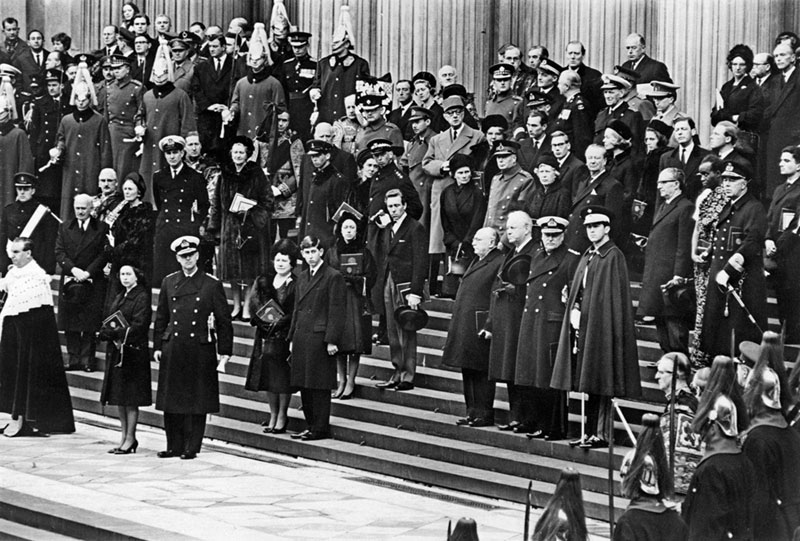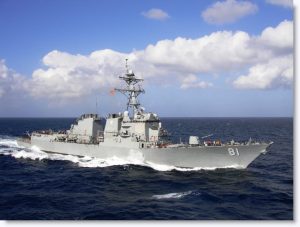
In Memoriam
110 Nations’ Leaders Attend Funeral Service

January 17, 2007

When I came to St. Paul’s Cathedral on the morning of Sir Winston Churchill’s funeral I was on foot. I thought it would be easier that way than competing with the hundreds of hired cars of kings and queens and presidents and prime ministers.
I tried first a tiny cobbled lane I knew opened on Ludgate Hill, near St. Paul’s, where the procession would pass. The opening was corked with people jammed so tightly that anyone who fainted would have stayed upright and perhaps even unnoticed for hours.
I tried other lanes and they were the same. I thought I would seek police aid and shoed a policeman at the back of the crowd my London police pass and my black-bordered invitation to sit in Seat 4, Row 11, Block H of the nave of the Cathedral Church of St. Paul.
The policeman said: “I can’t help you. You’ll just have to push your way through.” But then a man beside him said he would help by shoving from behind. He did while I kept saying ‘Excuse me’ and ‘I’m sorry’ to the agonized people who wanted to make way but could not move. When I got to the road and looked back there was not an inch of open space to show where I had passed.

2024 International Churchill Conference
Then I walked up the hill behind a truck spreading damp sand to ensure good foothold for the horses of the funeral procession.
My seat, I found, conducted there by ushers of the purple Rod, was in the second row from the rear, fourth seat from the aisle along which the processions would pass. I had a clear view forward more than 400 feel to the high altar at the east end.
About half that distance away, under the dome, was the clear area where the coffin would lie and royalty and other great personages would take their places soon. Behind me, across a clear space about 60 feet away, were the Great West Doors through which all ceremony would come and pass within six feet of me along the nave.
The Great West Doors are 40 feet high and of timber nearly a foot thick, strapped with iron and bearing great bolts. They open inward. My sight of them for the next hour was almost always this: three men stood by them, one on each side holding the doors open a few inches and a taller man behind them peering out through the crack When the tall man saw someone coming up the steps he would say a word. The other two would haul away mightily and the doors would swing open.
First through the doors that morning were Prime Minister Harold Wilson and his wife. They arrived even before the reception line of the churchmen was in position, the bishops with tall white mitres and many in robes of stiff black silk, wearing on their backs a silver crest of crossed swords centred with the letter D.
They made it there at 10:03, just in time to greet the tall General Charles de Gaulle, the shoulders of his military overcoat drooping as if his shoulders had been six inches wider when the coat was made.
He stopped a few feet from me in the procession. Behind were the U.S. and Russian representatives. He alone among them looked around keenly into faces. The others stared sombrely straight ahead along the blue carpe to the open space under the dome.
Swords dragged along the black-and-white stone checkerboard of the floor, sounding like a boy, a stick, and a picket fence. Maces went by borne by strong men in black breeches and stockings and shoes with gold buckles. Wigs went by. David Ben-Gurion of Israel, with his fringe of white hair, had walked from the Savoy because his religion forbids him to ride on the Sabbath.
The officers of arms, in gorgeous dress with sheer black mourning sashes running from left shoulder to right hip, went by. One limped, bent and old, and one had his back arched hard back, as if only by such exaggeration could he overcome the feebleness of his cane-supported legs.
As the arrivals came thicker and faster, those who knew the ropes shook hands with the seven principal churchmen at the door, but some of the representatives of the 110 nations shook hands with up to 12, it being difficult for strangers to distinguish the bishops from the minor canons. The man who occasionally had his hand shaken after that of the Archbishop of Canterbury always looked vaguely ill at ease, and sometimes tried looking the other way when he saw a hand coming.
The royal procession down the aisle was led by a short verger wearing spectacles. Then followed the total grandeur of church officialdom and power. The many-colored jewels of the cross of Canterbury preceded the burly archbishop, Dr. Michael Ramsey, who is built like an old fullback and has a great jutting jaw. He walked with his hands clasped in front of him, his forefingers to his lips.
There were others — and then the royalty. I was struck most by one juxtaposition. The Queen walked first, with Prince Philip at her left in naval uniform. Behind her directly was the Queen Mother in very high heels, with Prince Charles at her left, dressed in blue lounge suit and camel hair blue coat.
Behind the Queen Mother was Princess Margaret, her husband at her left. The three royal women in black, one behind the other, had a quietness and dignity that somehow caught the throat.
They were not long in place when the funeral procession arrived. Once more it was the long, sad procession of ceremony, but this time tinged with sweat. When all the grandeur had passed, there came the coffin itself.
There for the first time up close were the eight Grenadier Guardsmen with their heads bare, their bearskins laid aside, and beads of sweat on their faces from the exertion their duty cost them. The coffin is of solid oak. They laid their cheeks against the sides and took the weight on their shoulders and reached across each of them, under the coffin to grasp a handful of greatcoat on the other side as insurance against a slip.
I was not close enough to the coffin to observe that enclave where the greatest of the world’s homage officially was done. Then for me was the simplicity of being part of the congregation, kneeling, praying, rising and singing when bidden.
The organ played the hymns in a key too high for rusty tenors and too low for uncertain baritones, but standing there in the cold church, most of us in our overcoats dark and drab against the majesty of the place and the ceremony, we did our best.
Still even the hymn that begins Mine eyes have seen the glory of the coming of the Lord, normally a rouser, came out draggy and slow.
I could see the dean as he prayed and the archdeacon as he read the lesson. Far down under the high altar I could see the Archbishop of Canterbury as he prayed. The Duke of Edinburgh sang God Save the Queen, when we came to that. High in the dome a trumpeter sounded the Last Post and behind me, high in another gallery, sounded the stronger blaring Reveille.
The Grenadiers strained again at the coffin, their cheeks against the flag that draped it. A redheaded one had his eyes closed and his face in a grimace as he passed me.
The royalty left as they had come, in procession to the steps. The congregation waited to let the personages depart.
I watched a man with a long candle-snuffer going methodically about his duties. While the world’s great personages were still waiting for their cars to arrive, chairs were brought for the feeble ones. They sat there in their tall hats and waited while photographers carrying gear in scuffed suitcases left the cathedral.
As I left, edging through the crowd on the steps, I met the Archbishop of Canterbury, shoulders down, bucking the line back into the cathedral to keep warm until his car arrived. By the time I got to a nearby television set, Sir Winston’s last journey on the Thames had begun.
Subscribe
WANT MORE?
Get the Churchill Bulletin delivered to your inbox once a month.



